History of diving

The need to dive, rather than leisure, has motivated man at the beginning of history. The acquisition of food, the collection of pearls for use as goods, corals, etc., the execution of military actions, the desire to recover the submerged goods, have been linked to the inherent curiosity of the human being and the passion for making and inventing new things.
Prehistory of Diving
Surely we would not have imagined it, but more examples of those believed show us that man was already immersed in prehistory. However, the resources available were very simple: own lungs, boats full of air, stalks of reeds or other plants and, at most, hoods submerged full of air.
One of the most beautiful and ancient examples is the bas-relief of the Ninive. There you can see how several Phoenician prisoners escape the Syrian arrows: Diving in the Tigris River breathing air from previously inflated boats. It is a bas-relief of 2,889 years ago.

Linked to the military use of diving, there is also history around Alexander the Great. 2,336 years ago he hired several divers to conquer the city of Tyre. In fact, in the port there were several sunken obstacles to prevent access to aggressive ships and defend the city, which divers had to eliminate. They say that Alejandro himself went under the water inside a glass bell to inspect the works. The bell was named colinfa.
Bells and vegetable tubes are, according to the accounts of that time, the most used instruments for immersion. However, they also tried to invent more elaborate tools. They did not make much progress and were very ‘simple’ inventions from the current perspective, but it must be borne in mind that they had a very limited knowledge of the physical problems generated by sinking. And the main barrier of physics at that time was the arrival of air into the underground.
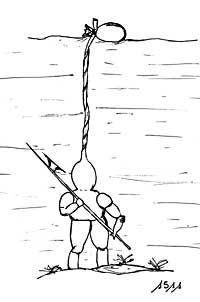
Flavio Vegecio, for example, describes a capusai in his works IV. At the end of the 20th century. The capusai has a tube to the surface of the water and a float tied at the end so that it does not sink or lie down. However, it would be difficult to sink much more than two meters under water, as pressure prevented air from coming down to it.
New ideas, XVI. since the 20th century
From the time of Flavio there were no significant advances and until the Renaissance no new ideas and projects appeared.
Thus, the images of Leonardo da Vinci show the respiratory tube and the fins of the hands. He also drew comments on what a submarine might be, around 1500. Giovanni Borelli also represented fins, but they were standing and with nails to facilitate the passage through the background. However, we do not have data to say that both models were tested or used.

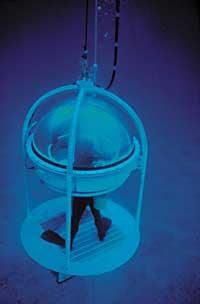
Following the images, there are some made in 1600 by the Navarrese Jerónimo Aiantz Beamount. In them appears a submarine with rowing. Fully enclosed and sealed wooden container. The air would be sent by the bellows located on the water's edge through tubes that, for proper distribution in the vessel, have fans driven by currents.
The disposal of the damaged air was regulated by valves. The submarine also had the way to move back and forth: the oar, and had a stone up and down hanging, that went up or down the inside by a lathe. It also had thick glass shutters.
As for the drawings and data of several authors, it is evident that the XVII began to distinguish two ideas for diving. In the nineteenth century: through divers, result of current personal and autonomous teams, and submarines. Anyway, they followed one way or another, and they continued to find a serious problem: how to renew the respiratory air. That was, in those times, the main barrier of subsistence.
The tests were performed in: England, France, Spain, Germany, etc. Some continued with the bells, others began with submarine boats, some with air powered by the bellows and others with compressed air tests.
John Lethbridge, for example, used compressed air in 1715. The air was sent by the surface of the water. The diver went into a wooden cylinder and could pull out his arms with a greased leather system. It seems that this system was used for many years.

But the advances of that century were not there. In fact, between 1771 and 1776, the French Freminet and the German Klingert manufactured helmets with locker and leather garments. These garments also had a metal structure. To breathe they used compressed air that came through a bellows caused by the diver himself. With this invention they began to impersonate the traditional costume of divers. Despite his discontent, in 1797 Klingert tested the new model: the scaffold with tanks, filled with compressed air by water pressure. What we do not know is the result.

At the same time, in 1788, John Smeaton devised a widely used system. He walked the way of the bells, but the air was transmitted by a bomb located on the surface. The advance of the bomb was important.
In addition, he subsequently made technical improvements and placed anti-return valves. Thus, the air did not recede if the pumps that had to be operated manually were stopped and the connection was cut. In a few years, all the major ports in the world had such equipment.
XIX, determinant
The 1800s was a decisive century, in which they began to devise and develop really autonomous teams and perform great tasks underwater. The XIX devised models for air to be driven by divers themselves. Throughout the 20th century, even more suitable helmets and garments.
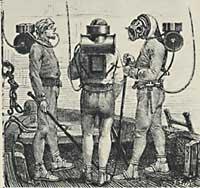
Among others, Charles A. Deane patented the firefighter helmet in 1823. With this helmet they could approach the fire without breathing any smoke, since the breathing air came through a hose. Five years later, he arranged it for water.
The first watertight scuba saw dates from 1837 and A. Patenta Sieb. The air came to the hull by means of a bomb and has been the model of all the scafandras that have been made since then.
The next important leap was the invention of air regulators (Rouquayrol and Denayrouse, 1865). On the back of the submarine was placed a steel cylinder with compressed air inside 20 atmospheres. The cylinder had a tube to the water surface to be able to introduce the new air. But also, thanks to the air regulator, only when breathing came air to the submarine, not without interruption. Using the cylinder, the diver had the possibility to release the tube from the surface and walk on his own. Yes, for a short time, because only 20 atmospheres can not accumulate much air.
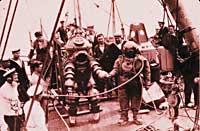
Years later, in 1878, Henry A. Fleus patented the first autonomous equipment. It used pure oxygen, stored at 30 kg/cm 2 pressure in a bottle of the back. The air expelled by the diver passes through a chemical filter and removes carbon dioxide, leaving the oxygen breathable again. In addition, the system is a closed circuit, so it does not generate bubbles. Therefore, the XX was used by armies from all over the world. throughout the 20th century. The only problem is that it cannot be used below 7-10 meters, as oxygen becomes toxic.
It could be said that the diving suit that already contained all the current ingredients was invented. From then on new tests, adjustments, creation and adaptation of new technologies, new techniques... advances such as the creation in USA of the typical diving helmet that we have seen many times and that has been used until 15-20 years ago, since 1905. In recent advances, the years 1935-45 were important, II. In the framework of the World War, Jacques Yves Cousteau had special relevance in the work of socialization of the underwater world.
New problems: decompression
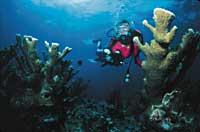
The first mention of decompression disease is very old, from 1667. Robert Boyle discovered that by having a snake under pressure, bubbles appeared in his eyes and suffered terrible pains. The observed remained.
Later, as respiratory mechanisms advance, the decompression disease of divers began to be known. In 1839 the cannons of the HMS Royal George were recovered at a depth of 20 meters, which caused divers to suffer a ‘rheumatism and cold’ after they emerged. Then they did not know why, but they had the decompression disease of divers.
To build the Brooklyn Bridge in New York (1869), the workers worked 'dry'. Advances in air ejection pumps allowed the construction of hyperbaric chambers, i.e. underwater under high pressure, but with dry chambers or boxes. So were the foundations of the bridge columns. They suffered strong pressure and half of the workers suffered paralysis. The engineer finished the bridge works in a wheelchair.

Research on physiological problems resulting from pressure changes was published by Frenchman Paul Bert in 1878. He showed that the disease is due to the nitrogen bubbles that occur by rapid outcrop and advised that it rise gradually. As a therapy to reduce pain it was pressing again. From then on, in 1908, John Scott Haldane published decompression tables that allowed them to descend to 60 meters deep.
Around the world thanks to divers
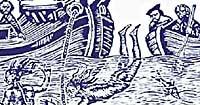
Of the three boats that sailed around the world, only one returned to Spain: Victoria boat. On the way he had to stay on the island of the Giver of Moluccas because water entered the boat. The king of the Tator called three skillful divers from across the island. They used their long hair to locate the currents generated by the filtered water. So they knew where the holes were and could repair them.
Jerome Aiantz Beamount (1553-1613)
Jerónimo Aiantz Beamount was born in the Navarra town of Guendulain. As a noble family, at the age of 14 he became a servant of the king.

In the Court he received a higher education, despite being raised, and in the XVI. At the end of the 20th century he was appointed manager of the mines of the kingdom. Therefore, many of his inventions sought to overcome the problems that arose in this profession. Among them are the underwater, which would be a steam pump and a steam ejector to extract water from the mines.
He demonstrated with the submarine on the Pisuerga River, where the king was also. The submarine was submerged about an hour and, they say, there would be more if King Philip III had not been bored.
It can be said that the first steam engine was also invented by her. In fact, he invented a steam pump to draw water from the mines – 80 years before English Thomas Savery made the steam engine. He also invented a steam ejector for the renovation of mine air.
Although Philip III issued in 1606 “invention privileges” of different tools, similar to current patents, his inventions were not very successful.
First...
… data: Crete sponges collectors, a.C. 3000 B.C. Year 2200. Divers used in the battle of Troy, a. C. Year 1194.

… record: Edmund Halley discovered comet Halley, patented the new system in 1691. It was a kind of bell or wooden barrel, but as a medium it used barrels to send new air. The bell had a small valve for the vicious air to come out by introducing the new air from the barrels. For an hour and a half he and four others remained 18 meters deep. And that is, we know, the first record of depth in history.
… deceased: Edinburgh Spalding is the first officer killed in scuba diving. He introduced improvements to the Halley bell: he discovered how to use water as a scab, introducing and removing water in a compartment. One day he ran out of the air and died. Previously they would also die more in diving, but it was officially the first dead of diving.
… school: In Spain, under a royal decree of February 20, 1787, diving schools were created in each Maritime Department. These schools are the oldest diving schools in the world.





